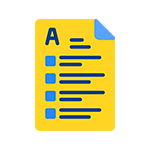Hyphen is a small punctuation sign that connects two words, compound numbers, and an awkward combination of letters. The primary purpose of this sign is to glue words together so that the reader understands that two or more components are linked. Commonly called the ‘dash’ hyphen proves very helpful in making sense of different terms.
Indeed, in its absence finding the meaning of different sentences would be highly challenging. Let us find out more about this punctuation symbol and its uses.
Table of Contents
What is a Hyphen?
A hyphen functions to join two words or their parts together. In the English language, there are many compound words. These words are made of two different nouns, verbs, and adjectives. For example, back-paddle, president-elect, and best-case.
All of these words rely on the use of a hyphen to link different words together.
Besides their usage to form compound words, hyphens also divide words on line breaks. Here are some examples of the usage of a hyphen in a sentence.
- The team had three right-handed players.
- The students were having fun playing with a jack-in-the-box.
- She has forty-seven dollars in her wallet.
- He is fond of studying literature from the pre-Victorian era.
8 Points When Should You Use Hyphens
You can use the hyphen in several ways. The following are some common uses of this symbol.
1. Hyphenate words coming before a noun
You must put a hyphen between two words that precede a noun. This is called a compound adjective. For example, an off-campus settlement or cutting-edge design.
Use hyphens when more than a single compound adjective comes before a noun that they change. For example, you will need to bear with a two-to-three-week delay in processing.
Hyphen is also used to create original compound words to emphasize certain situations. For example, the boy video-gamed his way through adulthood.
2. Use a hyphen with a noun, adverb, and present participle.
When you write a noun or adverb and a present participle to create a meaning that explains another term, use a hyphen. For example,
- Quick-acting drugs are helpful for those with migraines.
- There are numerous gorgeous-looking bouquets in the dining hall.
POINT TO NOTE: Never use a hyphen when combining an adjective and a participle.
3. Hyphenate compound adjectives with numbers
If you use numbers as the initial part of a compound adjective, use a hyphen to link them to the noun following them. It lets the reader know that both words act like a unit to change another noun.
This rule is applicable when the number is in digits or words. Here are some examples to help you better understand the use of hyphens in compound adjectives with numbers.
- Ashley knows much about thirteenth-century English literature.
- The company’s chairman gave a 20-minute speech to the managers.
- The girl threw a stone at the second-story window.
DO REMEMBER: There is no need to use a hyphen if the number is the second term in the compound adjective.
4. Use hyphens to divide words across two lines.
This isn’t a grammatical usage of the hyphen. It is used for formatting reasons in magazine articles and newspapers. Here are some rules for using this punctuation symbol to divide words or line breaks.
- Split a word after a full syllable. For instance, hyphenate cover as cov-er and not c-over.
- If the term finishes with -ing, it implies the splitting of a double consonant. For example, running will get hyphenated as run-ning.
- A word that naturally has a hyphen will get split as per the hyphen.
POINT TO NOTE: Never divide a word with syllables if there’s a single letter alone or if just two letters start a line.
5. Use a hyphen to prevent awkward reading of various words.
Without a hyphen, there can be a weird doubling of vowels. For example, if you write semi-independence without a hyphen, it would read as semiindependence.
Similarly, not using a hyphen can also make the reader misread some words. For example, re-collect implies collecting or gathering again. But recollect means remembering something. Similar is the case with re-creation and recreation.
6. Use a hyphen with prefixes.
Prefixes are terms that you use before a word. It is essential to use a hyphen with different kinds of prefixes. Look at these examples to learn the correct usage of hyphens with prefixes.
- Self-assured
- Mayor-elect
- Anti-American
- Mid-1980s
- Self-serve
- All-powerful
- Ex-wife
7. Hyphenate when the unit, symbol, or abbreviation in a physical quantity is spelled out
You must use a hyphen will all physical quantities when the abbreviation unit or symbol is spelled out. Here are some examples to understand it.
- 200-meter stretch
- 50-kilogram weight
- Eight-centimeter insect
8. Hyphenate high or low when they are part of a compound adjective
Use a hyphen in a compound adjective if the compound occurs before the noun it modifies. These examples in sentences will help you understand this hyphen usage.
- This vehicle runs perfectly on high-octane gasoline.
- Low-flying helicopters cause noise pollution.
- Getting a high-interest on your savings will help you save a lot in the long run.
When Should You Not Use a Hyphen
Now that you know the usage of this punctuation symbol, it would be wise to understand instances when it is not required. Let us start with something we have already covered.
- You use a hyphen in compound adjectives to make them clear to the reader. But if the compound adjective is clear, don’t use it.
- Adverbs ending in-ly are known to change the word following them. There’s no need to use a hyphen. For example, Widely attended gatherings need no hyphen because readers can gauge that widely modifies gatherings.
- Comparative or superlative adjectives also change the terms following them. There’s no need for hyphens. For instance, you don’t need to put hyphen while writing much maligned argument, better understood philosophy, higher scoring candidates, and the like.
- Don’t use hyphens between numerals and abbreviations. This is true even if the numeral and abbreviations are in adjectival form. Some examples include five cm caterpillar, 70 lb. Sack, 100 m dash.
- Never hyphenate proper nouns of more than a single word when they are in the compound adjective form. For example, while writing She is an academy award nominee, don’t put a hyphen between academy and award.
- Use a comma, not a hyphen, between two adjectives when you can use and instead. For example, I have some crucial, classified documents. Another example can be He got an exquisite, fragrant bouquet on his birthday.
- When explaining family relations, the word grand can be written without a hyphen. For example, My granddaughter and my grandaunt never met. Similarly, never hyphenate half-sister or half-brother.
Final Thoughts
Hopefully, this article will have given you much insight into the usage of a hyphen. Many students make mistakes in using this punctuation symbol mainly because there are many rules for using it. Refer to this guide whenever you need clarification about using hyphens correctly. If you need more clarification, contact our assignment help experts team.
 Santa Clara, CA 95050
Santa Clara, CA 95050 





